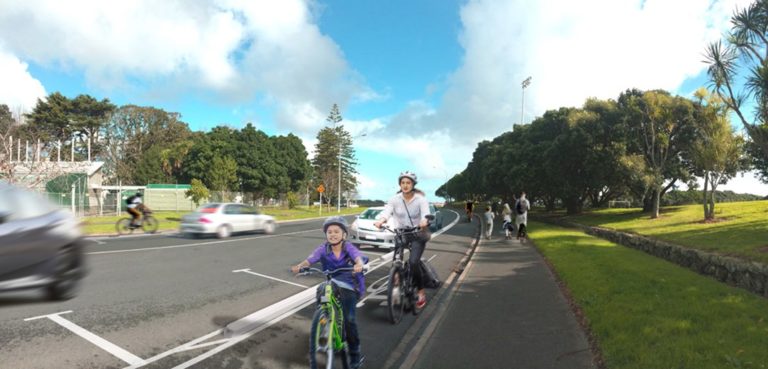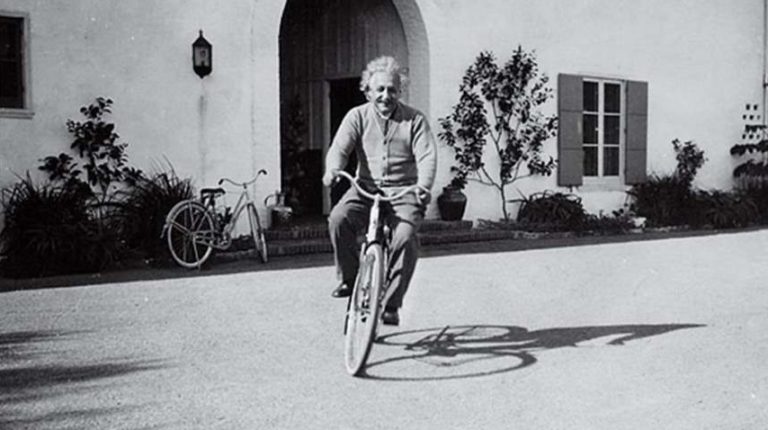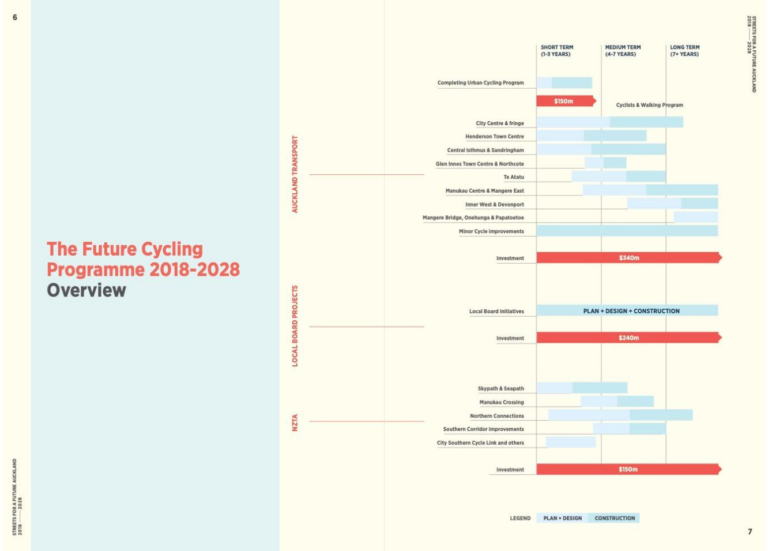Like most other things, Project Watch has taken on a very different flavour in 2020. We were just about to put out a bulletin in late March, when everything came grinding to a halt.
Well, almost everything. You kept riding, our advocacy wheels kept turning, and with a mild winter and bikes flying off the shelves, the lockdown bike boom shows no sign whatsoever of slowing down – there are shortages and waitlists until spring.
Just back from a great ride on the Waterview, southwestern and Te Auaunga paths. On all of them, there were people out on bikes and scooters and on foot, lots of family groups – more than there ever used to be. Lockdown this year was a discovery.
— Russell Brown (@publicaddress) August 9, 2020
From bike commuters to boomers on e-bikes to free-range kids, Aucklanders are racing to do their bit. Just as well, given Council has adopted a Climate Action Plan that aims for 7% of all trips by bike, by 2030. Luckily, 70% of New Zealanders are eager to see a green Covid recovery. We’re ready.
So what’s happening on the ground to protect, connect, and encourage all these happy, healthy, climate-action-taking, congestion-busting everyday heroes?
We’ll bring you detailed project updates in the coming days, but let’s start by getting up to speed on where things are overall – both here, and around the world. Buckle up, it’s a rollercoaster ride!
Time to Speak Up, Time to Take Action
Firstly, if you spoke up for cycling in the Emergency Budget consultation, a thousand times thank you! You helped deliver the 3.5% option, which means fewer overall cuts to so many things that matter to all of us. This is really important.
Transport was the most frequently mentioned topic in general feedback, with cycling (1557 responses, 74% positively inclined) hot on the heels of public transport (1730 responses, 67% positive). Also on people’s minds: road safety (97% positive) and climate action (95% positive), both of which included calls for more bike infrastructure.
The good news is that, in the final budget, Council managed to keep the libraries open and preserved some discretionary funding for Local Board initiatives. Councillors also found another $40m for transport, “including road safety”.
But the road ahead for safer cycling is muddy and uncertain – and many already delayed projects will be further delayed.
How is this possible, at this historical juncture, especially given the alignment of political leadership and public sentiment, and how heavily Auckland’s Climate Action Plan depends on decarbonising transport?
To begin to answer that, you need to read Greater Auckland’s recent post on what’s happened to Auckland Transport’s cycling programme over the last 3 years. And for once, do read the comments!
“The programme has effectively disappeared faster than a protected cycleway approaching a major intersection… In essence, [it’s been] squashed by a lack of internal champions, a lack of internal knowledge, a lack of ambition, a lack of courage and most recently a lack of budget.”
And the results are evident in AT’s list of projects for potential deferral, many of which were meant to have been already completed.

To be clear: anything that’s already under way or that’s been contracted will proceed. So, Karangahape Road, New Lynn to Avondale, and Tamaki Drive will chug along. The Victoria St cycleway (more about that later) is on track to open in October; and the Northcote Road bridge clip-ons will complete the Northcote Safe Routes. We’ll be taking a closer look at these in upcoming bulletins.
However, the other planned projects will go into design, but most likely won’t be built in the coming year. Details are yet to be confirmed, but we’d predict this will affect local projects like the Pt Chevalier upgrade and the Waitemata Safe Routes and the Glen Innes local links, and the essential Section 4 of GI2TD (Ngapipi Road).


A question mark also hovers over Great North Road, another key cycleway project that was meant to have been delivered by 2018, but got absorbed into a wider arterial project. Lockdown arrived just as a fresh design was about to go back out to the public. That new design looks good – and safety is both precarious and paramount on this corridor – but will it be built in time to connect with the Karangahape Road cycleway? And when will the Waitemata Safe Routes and Pt Chevalier meet it at the other end?

Also likely to be put on ice is the widening and separation of the dangerous Kingsland bottleneck on the Northwestern Cycleway, which is officially a safety project rather than a cycling project. A delay here is particularly hard to swallow, given the clear and present safety issues we raised in early 2018 and reiterated in 2019, and covered at length in the media. Heartfelt pleas by the Newton Central School community and principal Riki Teteina led AT to swift assurances that something would be done.
And yet, over a year after those assurances, delays have made this essential project vulnerable to the budget cuts. This is not good at all.

Auckland: a city out of step?
The confounding thing is that Auckland’s putting the brakes on just as our international cuzzies in the C40 Cities alliance (a global network of cities pledged to take “bold climate action”) are racing to deliver a healthy streets revolution – all of them under much more challenging conditions than we face. So we have a wealth of inspiring examples to draw courage from.
Paris roared out of the gate with 50km of emergency cycleways during lockdown – plus a plan for 650km of bike routes across the greater metropolitan area. They’re already over halfway there, and ridership is up 50% on last year!
“Our city could never be like Amsterdam.”
? ? ?This is now Paris’ reality ??
? @schlijper pic.twitter.com/7FCrlIcbA1
— Jonathan Berk (@berkie1) July 21, 2020
London has cranked into gear quickly by fast-tracking a bunch of low traffic neighbourhoods – something they’ve already had a head start on. Can you imagine even one of these in Auckland? How about one hundred and fourteen?? After all, we already know from lockdown how great it could feel.
As part of a five year "Mini Holland" scheme, the London Borough of Waltham Forest built:
? 22 km. of cycle tracks
? 40 modal filters
? two street closures
? 100 junction upgrades
? 15 pocket parksThe result? “More bikes, less cars, happy people!"https://t.co/XIDybcP2fN pic.twitter.com/Cg4cfnkLye
— Dutch Cycling Embassy (@Cycling_Embassy) August 9, 2020
And whatever his other merits, Boris Johnson – whose main regret as Mayor of London was not building more protected cycleways – is now spearheading a two billion pound national plan for:
“first hundreds, then thousands of miles of protected bike lanes, so anyone can ride safely; low-traffic neighbourhoods, to stop rat-running and make it easier to walk and cycle; bus and bike corridors on some main roads; and funding for a massive rise in e-bikes, all of which will open up cycling to more and different people and make places better for everyone. There will be vouchers to pay for bike maintenance, free cycling training for everyone who wants it, and parking changes to discourage the school run.”
Meanwhile, Barcelona has done “the work of months in just a few days”, starting with opening 35km of streets to walking and cycling.
And closer to home, Sydney announced six pop-up cycleways during lockdown, and is working on more, all designed to tie in with and supplement the existing cycle network.
Another pop up cycleway opens in Sydney – seem to be rolling out at a rate of one a week at the moment! pic.twitter.com/vjNDOGKC2n
— Strategic Cities (@StrategicCities) July 15, 2020
And, even closer to home, bike-friendly Christchurch scored a jolly good whack of government stimulus funding to roll out 37km of connections across the city: proof that once you’re really up and rolling, momentum keeps you going.
 And in cities all over, nimble “shovel-ready” projects are turning out to be as easy as pie, immensely beneficial for social cohesion while allowing for social distancing, and a massive boon for the hospitality sector as it recovers from the shutdown:
And in cities all over, nimble “shovel-ready” projects are turning out to be as easy as pie, immensely beneficial for social cohesion while allowing for social distancing, and a massive boon for the hospitality sector as it recovers from the shutdown:
Shovel ready project? Chuck these outside every pub, restaurant and cafe and keep them there. pic.twitter.com/k7Z5D6d0PF
— Paul Wellman (@PaulWellman_) June 24, 2020
Why squander all the hard work that got us here?
In the midst of overlapping climate and public health emergencies – and given the massive role transport must play in addressing both – we can all see the need for safe and healthy streets. And we can see there’s never been a better time to support the most humble, healthy and affordable ways to get around. To find clever ways to make every dollar go further. To be agile and courageous and smart and equitable.
Plus, hard times and creative constraints can lead to powerful paradigm shifts. As Ernest Rutherford – himself a keen cyclist in his Cambridge days – famously said: “We’ve got no money, so we’ve got to think.”
In other words, it’s time to get tactical and smart and loud! There’s a lot going on, and it’ll be more vital than ever to raise our voices for action: a chorus of every Aucklander who hopped on a bike in lockdown and saw what was possible.

But instead of seizing the moment for cycling, Auckland risks squandering the precious advantage we all gained by going hard and going early to keep Covid at bay.

Let’s be clear: investment delayed is investment denied. To reiterate Greater Auckland’s point, it’s time to ask why more cycling projects weren’t shovel-ready – and why more weren’t already underway.
- It’s three years since AT adopted its strategic ten-year Cycling Programme Business Case, designed to deliver on the Auckland Plan’s promise of building 70% of the citywide cycle network by 2030.
- It’s two and a half years since the new CEO of AT showed up in person to assure everyone of his “unwavering commitment” to delivering the bike network.
- It’s two years since Council and Government proudly declared (in ATAP) they’d be investing $900m in walking, cycling and Local Board priorities over the coming decade.
- And it’s a year since AT told us it would publish its cycling strategy “after the local body election”. A comprehensive document exists, complete with introductions by the Mayor and the Minister of Transport – but there’s still not a whisper of a cycling plan or strategy on AT’s website, not even on the page dedicated to plans and strategies!
Above all, there’s been a loss of capacity and capability precisely during the time AT knew it should have been building up muscle to deliver at scale and at pace. The promise that active transport would become “a priority for the whole organisation” hasn’t manifested.
And, as we predicted, the disbanding of the Walking and Cycling team has resulted in a steady loss of good people whose best efforts have been bogged down by the “clay layer” of business-as-usual.
While there are still great people at AT who keep the faith and get things done – for example, check out the most recent promising news about progress on bike parking – too many key folk have left the building, disillusioned, discouraged, and burnt out.
Oh dear. Surely there’s some good news?
Yes. Most of those champs and experts aren’t lost to Auckland. Some have moved sideways within the Council family, and many into Waka Kotahi/ NZTA, which oversees the major cycleway projects along motorway corridors.
Waka Kotahi is forging ahead with cycleway projects for Auckland including the Northern Pathway (aka Skypath and Seapath), with two major consultations on that project. Work continues on the Southern Pathway from Takanini southwards and the Northern Corridor around Albany.
We’re curious about what’s happening with other vital north-south connections, like the promised investigation of a connection from Newmarket to Ellerslie. But the recent sod-turning for the start of construction on Section 2 of the Glen Innes to Tamaki Drive pathway was another sign that the big network connections are taking shape.
Waka Kotahi is also venturing into supporting projects on local streets. AT’s former cycling champion Kathryn King now leads the Innovating Streets for People programme. Launched with what turned out to be accidentally perfect timing (and grabbing international headlines with a big boost to the fund courtesy of the Associate Transport Minister), this programme supports councils around the country to roll out quick and clever, easily tweaked projects to encourage walking and cycling.
At a 90% funding assistance rate, the Innovating Streets fund is a gift for communities looking to try things out and have fun with public space – including creating low-traffic neighbourhoods. (A recent rule change allowing art on the road surface adds to the possibilities). It couldn’t be better designed for a post-Covid reality – and again, there’s no shortage of fantastic examples from around the world to inspire us.
Worryingly, however: almost all of AT’s first tranche of proposals for this coveted funding apparently didn’t meet the mark – most being either too temporary, or too permanent.
Even the pop-up protection programme, which we’ve been pushing AT to deliver over the last year – and which might have given AT the skills to move fast in this new world by being “shovel-ready” and good to go – seems to have fallen between the cracks. Scoped at $30m to create 100km of protection on existing bike lanes within one year (talk about quick wins!), it seems to have been too big (or too basic?) for Innovating Streets, and too small-potatoes for the stimulus funding. And its champion, too, has left the building.
Speaking of stimulus funding, we should note that the government’s “shovel-ready” fairy has granted a big boost to a major pathway out west, plus the NW busway. In theory at least, this sustainable shot in the arm frees up significant budget at AT’s end, which could, in theory, be rededicated towards active transport.
Told you it was a rollercoaster ride!
A call to arms (and feet on pedals)
What this all adds up to is that our city risks being becalmed in the cycling doldrums for some time to come – right at the very moment more Aucklanders than ever are taking to the streets on bikes.
And just when we need them most to be on top of their game, Auckland Transport in particular is hitting rock bottom on commitment, expertise, and champions.
But we are the champions, my friends!
This situation puts us, and you, in the unusual position of supplying leadership, strategy, and continuity. People-powered volunteer-led advocacy will lead the way.
We don’t hold the purse strings. But we do hold the vision, and we are the voice.
Our call is the same as it was when this Council was elected. To get the change we’ve been promised and that our city deserves, we need:
- bold and courageous leadership – unapologetic champions who are loud and clear on the benefits of a bike-friendly city.
- vital investment for a healthy city – budgets that match all the beautiful words. And
- quick wins for real change – smart, creative sensible actions that get Aucklanders moving the way we know we can.
So if you’ve been tossing up whether to get involved, now’s the time. Stay tuned for detailed project updates in coming days. And keep talking with your neighbours. Because together we can make the case to build back better with bikes!
Conversations with the neighbours, via @biketeatatu:
Driver shouts to me: "Do you know what's going on?"
Me: "Yep, loads of cars with just one person in them"
Driver: "Hmm how much does a bike cost" pic.twitter.com/Qv9xA3WpYz— Bike Auckland (@BikeAKL) August 4, 2020









